11186 A PAIR OF SUPERBLY DRAWN CARVED BEECHWOOD FOOTSTOOLS CLOSELY MODELED ON AN EGYPTIAN TWENTY-SIXTH DYNASTY EXAMPLE IN THE MUSÉE DU LOUVRE Probably French. Nineteenth Century. Measurements: Height: 11 3/4″ (29.8 cm) Width: 18″ (45.7 cm) Depth:19 3/4″ (50.8 cm).
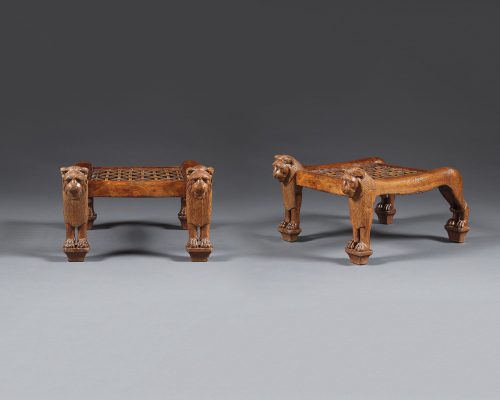
Research
Of stained beechwood. Each with rectangular top plaited replaced leather straps, the front legs with carved lion heads continuing into paws, the back legs with entwined tails, all raised on tapering gilt block feet.
Provenance:
Private collection, New York.
This pair of stools takes as its direct prototype an ancient Egyptian footstool from the Late Period (664-332 BC), in the collection of the Musée du Louvre (Inventory number E 10780) (figure 1). The Louvre example is of very nearly identical dimensions (Height: 28.5 cm; Depth: 51.5 cm) and is located today in the Sully Wing, Salle 8. The piece dates from the 26th Dynasty, also called Saïte period (relating to the period when the Pharaohs ruled at Saïs), and entered the Louvre collection in the 1899 via the antiquarian and antiquities dealer Mihram Sivadjian, having formerly belonged to the family of French diplomat Ferdinand Marie, Vicomte de Lesseps. Lesseps served as vice-consul to Tunis, and consul to Cairo and Alexandria in the 1830s, where he befriended Said Pasha, son of the viceroy. After his retirement from diplomatic service, he returned to Egypt when Said Pasha became viceroy in 1854, and was given permission to initiate and oversee the development of the Suez Canal. Ferdinand’s father had also spent time in Egypt before his son, and knew Bernardino Drovetti, French Consul General to Egypt, who had an important collection of Egyptian objects, some of which were also acquired by the Louvre. By the 1930s the stool was exhibited in the Antiquities department in a room showcasing funeral furniture.
The design of the stool “testifies to the perenniality of Egyptian art, which has preserved the same models throughout the centuries and the successive dynasties.” Furnishings with lion’s feet had been popular from the 4th Dynasty, some 2,000 years earlier, and “Saïte pharaohs deliberately adopted much from the culture of earlier periods, particularly the Old Kingdom, as the model for their own.”1
Another furniture leg of related design, but made in faïence, dates from the Late Period (circa 4th century BC) and is in the collection of the Metropolitan Museum (figure 2). This leg was intended to slot onto another component of furniture, probably made of wood, and due to its fragile nature may have been intended as a funerary item rather than an object of every day use.
Ancient Egyptian carpenters made pieces of sophisticated quality and technique given the technology of the age, and applied decoration adorned the finest pieces. The furnishings and objects contained within an Egyptian tomb were commensurate with the deceased’s position in life. Ordinary furnishings employed plain legs, and in the homes of peasants and even some average upper-class households, there was little to no furniture at all.3 Royal and upper-class chairs and beds “terminate in the carvings of the paw of the lion: the imperial beast. Perhaps the intention was to imbue the occupiers with the animal’s strength and spirit.”2
In ancient Egypt, the lion enjoyed sacred status as a symbol of strength, courage and power. They were hunted but also revered, “thought to have been bred in sanctuary precincts, where they were ritually fed and buried in a sacred animal necropolis.”4 The lion was often equated with royalty; both the pharaohs Ramses II and Ramses III kept a lion as a pet. However, the animal was particularly associated with the goddesses, many of whom are represented with the face of a lion, such as Sekhmet, a deity of war and also healing (figure 3).
In Europe, an era of discovery and cultural appropriation in the decorative arts, spanning the 18th and 19th centuries, can be seen as an Archaeological Revival, which included the trend of Egyptomania. Napoleon’s military successes in Egypt at the end of the 18th century fueled excitement for the style. His artistic advisor, Baron Vivant Denon (1747-1825), traveled northern Egypt during these campaigns, recording all he saw in notes and sketches. The resulting two-volume work, Voyage dans la basse et l’haute Égypte, published in 1802, “can be said to be the first attempt to provide comprehensive and accurate descriptions of Ancient Egyptian architecture,”5 and spurred the Egyptian Revival in architecture and decorative arts. Seven years later, the Institut d’Égypte released its encyclopedic tome, Description d’Égypte, published in twenty-three volumes between 1809 and 1829, bolstering the enthusiasm for Egyptiennerie across Europe.
These early French archaeological surveys paved the way for many expeditions in places like Alexandria, Cairo and Thebes. Beginning in 1815, under British Consul General Henry Salt, important exploration and excavation projects were undertaken including the head of Ramses II, the temples at Abu Simbel, the pyramids at Giza and the great Sphinx. His contemporary (and rival), was Bernardino Drovetti (1776-1852), who was particularly active in Luxor, and collected a vast number of antiquities through agents to be sold abroad. In the succeeding decades Egyptologists from across the Continent contributed to discovery and removal of ancient Egyptian artifacts, culminating in perhaps the most famous finding, the Tomb of Tutankhamun, made by Howard Carter in 1922.
The influence of these archaeological discoveries on the decorative arts is exemplified by the faithful reconstruction of objects copied from wall paintings or extant antiquities. For example, an armchair formerly in the Carlton Hobbs collection was reproduced from a watercolor in the series Le Description de l’Egypte by the French artist André Dutertre, which he copied from a wall painting in the tomb of Ramses III. While many designers, such as Thomas Hope in England and Percier and Fontaine in France, used ancient models to create stylized interpretations, the present stools, like the Ramses throne, are set apart for their archaeological accuracy in design and construction.
These beautifully drawn stools differ from early 19th century ‘retour d’Egypte’ examples, which often fail to evoke the ancient atmosphere of an item of furniture or objects. Similarly, those items produced in the 1920s by Liberty & Co. inspired by the ‘”King Tut” excavation have a stylized slickness, which are even less authentic in appearance. It would appear that the maker of the present stool set out to make a scholarly evocation of an item from the 26th Dynasty, as well as recognizing the genius of the original ancient Egyptian designer who created an object that felt as contemporary at the turn of the last century as it does today.
Footnotes:
- Allen, James, and Marsha Hill. “Egypt in the Late Period (ca. 712–332 B.C.).” In Heilbrunn Timeline of Art History. New York: The Metropolitan Museum of Art, 2000–. http://www.metmuseum.org/toah/hd/lapd/hd_lapd.htm (October 2004)
- White, Jon M. Everyday Life in Ancient Egypt. Dover Publications, 2012. 100.
- Ibid., 102.
- Lovgren, Stefan. “Egyptian Lion Mummy Found in Ancient Tomb.” National Geographic. National Geographic Society, 14 Jan. 2004. Web. 01 Feb. 2017.
- Curl, James S, and James S. Curl. The Egyptian Revival: Ancient Egypt As the Inspiration for Design Motifs in the West. Abingdon [England: Routledge, 2005. 204.
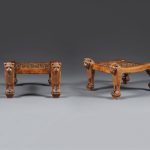

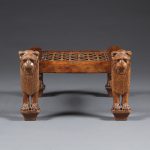
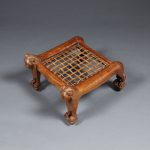
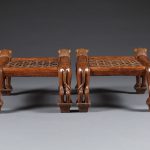
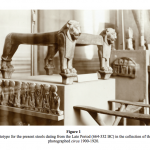
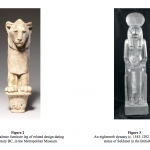

Comments are closed.